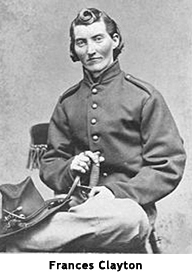An incredible deception…
Frances Clayton could chew, smoke,
drink, fight as well as any Union soldier
By DR. JUDY PIERCE
Bugle Staff Writer
During a burial detail, after the Battle of Gettysburg in July of 1863, the men were shocked to discover the body of a Union soldier that was a female. Another burial detail near Cemetery Ridge on the Gettysburg Battlefield uncovered the body of a woman wearing a Confederate uniform. These burial details found one of the most intriguing secrets of the Civil War; the multitudes of women who fought in the front lines.
 Some women soldiers joined the military for sheer excitement and a thirst for adventure, the promise of reliable wages, or ardent patriotism. Others wanted to be with their loved ones. One such woman from Minnesota named Frances Louisa Clayton (there are different spellings of her last name such as Clalin, Clatin, or Clatin) joined the Union Army with her husband.
Some women soldiers joined the military for sheer excitement and a thirst for adventure, the promise of reliable wages, or ardent patriotism. Others wanted to be with their loved ones. One such woman from Minnesota named Frances Louisa Clayton (there are different spellings of her last name such as Clalin, Clatin, or Clatin) joined the Union Army with her husband.
When the Civil War began in 1861, Frances and her husband, Elmer, lived on a small farm in Minnesota. During that year, President Lincoln issued a call for 75,000 volunteers to help squelch the rebellion and reunite the nation. Frances and her husband were very patriotic and enlisted in the Union Army. Since it was against the norms of society and the law for women to fight in the war, Frances cut her hair short, dressed as a man and was mustered in as Jack Williams.
Available sources are filled with contradictions; the National Archive states that she served with the Missouri Volunteers, whereas the Library of Congress lists her with the Minnesota State Militia Cavalry and 2nd Minnesota Battery. She is said to have fought with artillery or infantry, although the most common photograph of her shows her dressed as a cavalry trooper.
It was very easy for Frances to pass the required physical exam. She was very tall, masculine looking, and had a deep bronze complexion from working outside on the farm. In order to help her deception as Jack Williams, she learned how to chew tobacco, spit, smoke, drink, swear, walk and act like a soldier. She appeared to like cigars. Frances even gambled with fellow soldiers. She was very good in her deception. Whether standing guard or doing picket duty, she acquitted herself well and never raised suspicions about her true identity. Accounts noted she was an excellent “horseman” and “a capital swordsman.” Clayton carried herself in stride as a confident soldier, erect and ready to fight.
At the end of 90 days, the Civil War had not ended as most northerners believed it would. Records indicate Frances and her husband fought with a variety of the cavalry, infantry and light artillery. They fought side by side in as many as 17 battles including Fort Donelson and Stone’s River.
The Battle of Fort Donelson was fought in Tennessee, Feb. 13, 1862, which the Union won after three days of fighting. During this battle, Frances was wounded, but not discovered because of her injury.
The Battle of Stone’s River (referred to by the Union) or Murfreesboro (referred to by the Confederacy) was fought from Dec. 31, 1862 until Jan. 2, 1863. Since the only unit from Minnesota that fought at Stone’s River was the 2nd Minnesota Battery, it is highly probable this was the regiment Frances and Elmer joined after the cavalry enlistment expired.
The 2nd Minnesota Battery was assigned to Gen. William Rosecrans’ Army of the Cumberland. On New Year’s Eve 1862, they met Gen. Braxton Bragg’s Confederate forces at Murfreesboro (referred to by the South), Tenn. Both generals formed plans to attack his opponent’s right flank, but in the early hours of Dec. 31, Confederate William J. Hardee attacked the Union’s right flank. Some of the Union troops under the command of Brig. Gen. Richard W. Johnson were just getting up or eating breakfast when they heard the “Rebel yell.” The battle continued until Jan. 2, 1863.
By 10 a.m., Hardee drove the Union troops back three miles to the railroad and the Nashville Pike, where Johnson was able to rally them. As Rosecrans raced across the battlefield directing units, his uniform was covered in blood from his friend and chief of staff, Col. Julius Garesche, beheaded by a cannonball while riding along.
By noon on Dec. 31, the Union forced the Confederates to the defensive as they halted attacks and began advancing. During the three days, there were several attacks and counterattacks. It was during one of the early morning attacks against the Confederate forces, that Frances was positioned on the rear line of the assault while her husband was on the front line. The Minnesota regiment was ordered to make a bayonet attack on the Confederate forces. During the assault, her husband was killed just a few feet from her. Filled with grief and rage, she charged over his body with the other soldiers and drove the Confederates back.
The Battle of Stone’s River was tactically inconclusive. Total causalities in the battle were 12,906 on the Union side and 11,739 for the Confederates. These two armies would meet again at Chickamauga.
There are two stories about how Frances was discovered being a woman. One is that after the Battle of Stone’s River, Frances decided to let her true identity become known. As a result, she was discharged a few days later in Louisville in 1863. The other story is that Frances was wounded in the hip by a minie ball at Stones River. She was taken to the regimental hospital for treatment where her gender was discovered by the doctor. Gen. Rosecrans was immediately notified and he ordered her discharged from the regiment on Jan. 3, 1863. Frances tried to correct the errors, but this created even more doubts about what really happened.
After Frances was discharged and on her way back to Minnesota, the train was attacked by a Confederate guerilla party between Nashville and Louisville. She was robbed of her valuables, papers and money. After reaching Minnesota, she headed back to her regiment under the guise of retrieving her husband’s belongings. It is speculated she really wanted to plead with the commander to allow her to return to the regiment.
Unfortunately, Frances did not make it back to her regiment. She was stopped by the Provost Marshall in Louisville and ordered to return to Minnesota. She was put on a train schedule that was routed to Chicago and then on to Minnesota. Her reservations were confused and she ended up in Kalamazoo, Mich. She then traveled on to Grand Rapids. Afterward, Frances was walking away from the Provost Marshal’s office when a group of intoxicated soldiers began to follow her. When they became aggressive, she drew her pistol, turned on them, and with a few choice four-letter words, apparently changed their minds about the assault and ran away.
Continuing to walk through Louisville, Frances was recognized as an old friend by the owner of a local restaurant on Monroe Street. He knew her before she was married and was aware of her disappearance after her husband enlisted in the army.
The restaurant owner gave her lodging for the night. The next morning she boarded the train for Minnesota. She was last seen headed to Washington, D. C.














 Some women soldiers joined the military for sheer excitement and a thirst for adventure, the promise of reliable wages, or ardent patriotism. Others wanted to be with their loved ones. One such woman from Minnesota named Frances Louisa Clayton (there are different spellings of her last name such as Clalin, Clatin, or Clatin) joined the Union Army with her husband.
Some women soldiers joined the military for sheer excitement and a thirst for adventure, the promise of reliable wages, or ardent patriotism. Others wanted to be with their loved ones. One such woman from Minnesota named Frances Louisa Clayton (there are different spellings of her last name such as Clalin, Clatin, or Clatin) joined the Union Army with her husband.